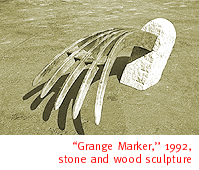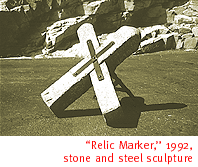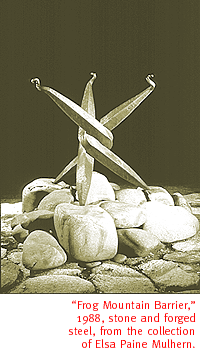
For 20 Years, Fred Borcherdt Has Wrestled Our Connection With The Land From Stone, Steel And Wood.
By Margaret Regan
FOR MORE THAN 20 years, sculptor Fred Borcherdt has presided
over the Tucson valley from a house and studio perched high above
Ventana Canyon.
 He can see Baboquivari and Kitt peaks miles west of town, the
Santa Ritas to the south, and everything in between. Over the
years, he has watched long ribbons of roadway unfurl across the
desert floor and houses take root, as people spread from one end
of the valley to the other and marked the land with signs of their
occupation.
He can see Baboquivari and Kitt peaks miles west of town, the
Santa Ritas to the south, and everything in between. Over the
years, he has watched long ribbons of roadway unfurl across the
desert floor and houses take root, as people spread from one end
of the valley to the other and marked the land with signs of their
occupation.
Coincidentally or not, Borcherdt has long been preoccupied by
the human tendency to mark our presence on the land, and his monumental
sculptures in stone, steel and wood reflect that.
"It's something humans have done since the first person
piled rocks on one another," Borcherdt says. "There
are all different kinds of ways we still do it. It's like making
sculptures: you're signifying your existence. Everything I do
is a marker in a sense."
 Named this year's Stonewall artist at the Tucson Museum of Art--the
13th such artist from the Southwest to win the honor--Borcherdt
has a one-person exhibit at the museum showcasing his works from
the last 20 years. His beautifully crafted sculptures are not
easy to characterize. They have a contemporary, pared-down look,
but they incongruously combine historic materials from different
technological eras. Rocks of the Stone Age mesh harmoniously with
Iron Age metal. Timeless wood is polished or painted. The works'
colorations are subtle, but gorgeous. Gray rock pairs with rusted
metal; odd industrial hues like lime-green or orange color hand-forged
steel.
Named this year's Stonewall artist at the Tucson Museum of Art--the
13th such artist from the Southwest to win the honor--Borcherdt
has a one-person exhibit at the museum showcasing his works from
the last 20 years. His beautifully crafted sculptures are not
easy to characterize. They have a contemporary, pared-down look,
but they incongruously combine historic materials from different
technological eras. Rocks of the Stone Age mesh harmoniously with
Iron Age metal. Timeless wood is polished or painted. The works'
colorations are subtle, but gorgeous. Gray rock pairs with rusted
metal; odd industrial hues like lime-green or orange color hand-forged
steel.
About a third of the pieces in the exhibition are from his Markers
series, the most literal being "Descanso," a 1998 stainless
steel cross embedded in stone. It memorializes the rest stops
in Mexican funeral processions, Borcherdt says, and by extension
calls to mind the wooden crosses planted along roadways to pinpoint
an accident victim's place of death.
It's tempting to connect the artist's Markers to the human
scarrings of the desert during the recent decades of explosive
growth, but he discounts the notion. His art does grapple with
the tension between connecting with nature and conquering it,
but the matchbox houses that have taken root below the mountain
are functional structures, Borcherdt says, not the metaphorical
markings he has in mind. He aims for work that creates a sense
of place.
 "A lot of the pieces are kind of personal markers of places
that are significant to me," he says. "That information
is not necessarily in the title, but in a sense they're autobiographical."
"A lot of the pieces are kind of personal markers of places
that are significant to me," he says. "That information
is not necessarily in the title, but in a sense they're autobiographical."
"Momentum Marker," for instance, a 1991 stone and wood
piece, came out of a lightning strike on a friend's ranch in the
San Pedro Valley. A mesquite tree was damaged and Borcherdt carved
the trunk into a zigzag, easily recognized as a universal symbol
of lightning. The slash of wood, now smoothly polished with characteristic
Borcherdt craftsmanship, is set between two rough boulders, each
of which in turn has been given additional marks by the sculptor.
The artist incised the boulders with lines that suggest a stonework
wall, or reaching back earlier in time, a petroglyph pecked onto
rock.
Like "Implement No. 8," 1982, a sort of giant stone-and-steel
slingshot, many of Borcherdt's works seem to be tools, though
which tool in particular is impossible to say. The pieces in the
Implements and Artifacts series suggest historic
objects whose useful life is now over, abandoned wheelbarrows
or plows or hooks, mutated and somehow sanctified by the artist's
hand. He often finds the accidental souvenirs of previous occupants
on his property--pot sherds or buttons or bits of old tools, writes
TMA curator Joanne Stuhr in a catalog essay. His sculptures, meant
to be erected outdoors, are intended to replicate that experience
of serendipitous discovery.
Borcherdt's own need for a house led in a direct way to the techniques
he uses in his art. In 1970, Borcherdt bought the land on the
mountainside, and lived in a 1920s caretaker cottage on the ranch
below until the house was ready. His first task was to build his
own road.
"I didn't know any better," he says. "I bought
a bulldozer and built a quarter-mile long road. It took all the
mystery out of stone."
 Along the way to the end of the road, Borcherdt learned quarrying
and blasting techniques, a "formidable challenge (that) gave
him the skills to work with stone as a sculptural material,"
as Stuhr notes. He also taught himself old-fashioned blacksmithing
techniques, so that he can work his metal when it's hot, manipulating
it into snake-like twists ("Feat Marker," 1991) or curled
nails ("Spur Marker," 1996).
Along the way to the end of the road, Borcherdt learned quarrying
and blasting techniques, a "formidable challenge (that) gave
him the skills to work with stone as a sculptural material,"
as Stuhr notes. He also taught himself old-fashioned blacksmithing
techniques, so that he can work his metal when it's hot, manipulating
it into snake-like twists ("Feat Marker," 1991) or curled
nails ("Spur Marker," 1996).
Borcherdt may have been one of the first human residents on the
mountain, but he hasn't been the last. He's made at least one
sculpture as a protest against what he calls, in a stroke of understatement,
"the spoiling of the neighborhood."
"Frog Mountain Barrier," positioned near the entrance
to the TMA show, takes its name from the title of a Charles Bowden
book that excoriates the corruption of the Catalinas. Borcherdt's
1988 sculpture has a twist of angry metal rising up from an artful
assemblage of polished stones. Like most of Borcherdt's evocative
amalgams of stone and metal, this one's ambiguous. Is the sharp-hooked
metal an angry defender of the pristine land? Or does it signify
the triumph of the developer?
Contemporary Southwest Images XIII: The Stonewall Foundation
Series, "Fred Borcherdt: Twenty Years,"
continues through May 2 at the Tucson Museum of Art,
140 N. Main Ave. Hours are 10 a.m. to 4 p.m. Monday through Saturday,
noon to 4 p.m. Sunday. For more information, call 624-2333.

|





